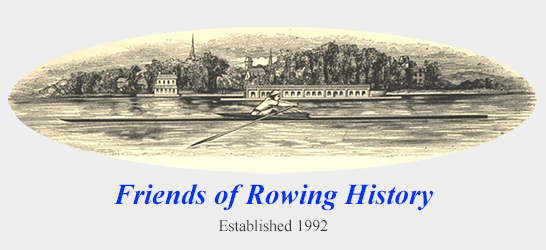A Brief Time Line of Rowing History
Thomas E. Weil
1850-1899
1850’s · Illustrations of boat races were first published as woodcut engravings in U.S. newspapers and magazines.
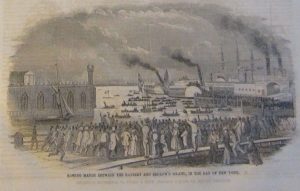
Gleason’s, Aug. 16, 1851, Thomas E Weil Collection
1851 · Gothenburg RC was established in Sweden [Dodd].
1852 · In the first intercollegiate athletic contest in the United States (August 3), Harvard defeated Yale in an eights race on Lake Winnepesaukee . This boat race has been held annually, with few exceptions, since 1864 and on the Thames River at New London, Connecticut since 1878.
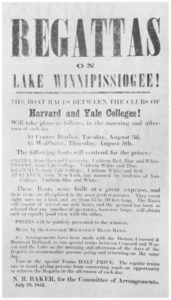
1853 · Bachelor’s Barge Club was founded in Philadelphia (July 4), followed in May 1854 by the University Barge Club, and in May 1856 by the Undine Barge Club, all of which are active today.
1854 · The first Boston City regatta, typically celebrating Independence Day, was held.
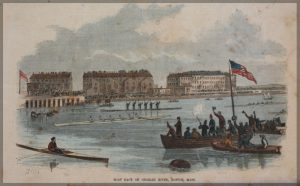
Writing under the pseudonym “Oliver Optic,” William Taylor Adams published THE BOAT CLUB, a story involving a group of boys who band together for rowing exercise and competition, which became one of the most widely-read juvenile books of the 19th century.
Matt Taylor built the keelless four that carried the Royal Chester Rowing Club to victory in the Stewards and the Wyfolds at Henley in 1855; thrilled, they returned in 1856 in a Taylor made keelless eight to take the Grand and the Ladies. The four is on display at the River & Rowing Museum in Henley.
1855 · The Neptune from St. John, New Brunswick emerged victorious from the first U.S.-Canadian rowing contest, spurning coxswain or rudder to defeat the coxed J.D.R. Putman of New York for $2,000 on the Charles in Boston.
1857 · J.C. Babcock of New York adapted a form of slide in a single; he subsequently outfitted a six-oar with slides in a race in May 1870.
1858 · Brown, Harvard, Trinity and Yale boat clubs planned the first inter-collegiate regatta, to be held using six-oared boats in Springfield, Massachusetts, but it was canceled after the Yale stroke drowned.
The crew was the first Harvard team to use red (later crimson) as a school color (June 19). A Worcester, Mass. newspaper reported the day after the 1868 Harvard victory that a crowd of jubilant supporters celebrated well into the night and “painted the town red”. Thus, an American expression was coined.
The Schuylkill River Navy was formed by several Philadelphia boat clubs (October 5).
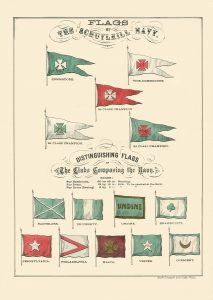
The first international boat race between French and English boat clubs took place in Paris [Dodd].
The Rower’s Manual, the first nominally American rowing text (although it drew heavily upon English precedents), was published; it includes a section advocating rowing for women.
1859 · Melbourne University Boat Club was established in Australia.
The Schuylkill Navy held its first regatta (June), in which six-oared boats predominated.
Josh Ward won the U.S. professional single sculls title (October 11).
1861 · The British Rowing Almanac commenced publication. In the same year, Thomas Hughes published Tom Brown at Oxford (a sequel to his immensely successful Tom Brown’s School Days), with the first widely disseminated descriptions of rowing at Oxford and Cambridge.
The Civil Service Rowing Club was formed in Cape Town, South Africa, as well as the Canterbury Rowing Club in Christchurch, New Zealand [Dodd].
1862 · James Hamill defeated Josh Ward on the Schuylkill for the U.S. professional single sculls title (August 13).
1863 · Boat clubs were established in Austria, Italy and Switzerland [Dodd].
A German, Dr. Schiller, reported developing a slide using wheels [Dodd].
Tynesider Robert Chambers defeated the Australian Green in the first international world championship professional sculling contest.
1865 · The Ward brothers were victorious over the Biglin brothers for the professional four-oared championship of America (September 25).
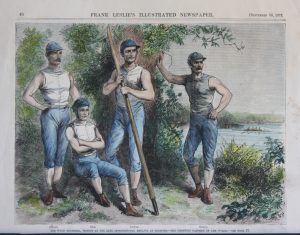
Frank Leslie’s Illustrated News,
Bill Miller Collection
1866 · James Hamill of the U.S. lost twice on the Tyne to Henry Kelley, the English champion, in the first trans-Atlantic professional rowing contest (July 4th and 5th).
Rowing clubs were organized in Denmark, Japan and Portugal [Dodd]. The Danish club continues to flourish today as Roforeningen Kvik.
British rowing eminence Edwin Dampier Brickwood called for the establishment of formal and exclusive standards for amateur status in the sport.
1867 · The first trans-Atlantic race between professional crews took place in Paris (July 7), where four Canadian oarsmen from Saint John, New Brunswick, who became known as the “Paris Crew”, defeated all comers at the Exhibition regatta.
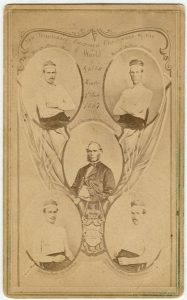
Thomas E Weil Collection
1868 · “Guts” Woodgate introduced the coxless-four at Henley by devising a foot steering mechanism and having the coxswain leap out after the start (Miller).
The Saint John “Paris” four defeated the Ward brothers boat at Springfield, Massachusetts (October 8).
1869 · Oxford defeated Harvard in coxed-fours on the Thames in the first trans-Atlantic amateur boat race before 500,000 spectators; broad news coverage of the race was soon followed by an explosion of interest in rowing and in the formation of hundreds of boat clubs in the U.S.
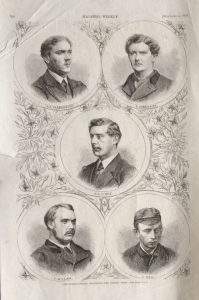
Harper’s Monthly Nov 1869,
Bill Miller Collection
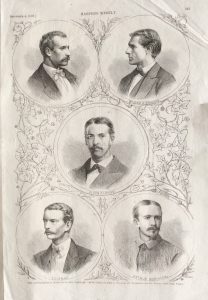
Harper’s Monthly Nov 1869,
Bill Miller Collection
1870’s · Schoolboy rowing programs were established in the U.S. at schools such as St. Paul’s.
1870 · The control of river traffic by the Thames Conservancy during the Oxford-Cambridge Boat Race inaugurated a useful custom of race day cooperation between regatta officials and municipal authorities.
Yale was the first U.S. college crew to use a slide, utilizing greased runners in the Yale-Harvard boat race.
A Tyneside four led by Renforth, who had captured the sculling championship in 1868, defeated the Saint John “Paris” crew at Lachine, Canada; in a re-match on the Kennebecasis River in New Brunswick in 1871, Renforth collapsed during the race, and died shortly thereafter.
1871 · Thomas Eakins finished “Max Schmitt in a Single Scull” (also known as “The Champion Single Sculls”), the first of his groundbreaking paintings of amateur and professional oarsmen.
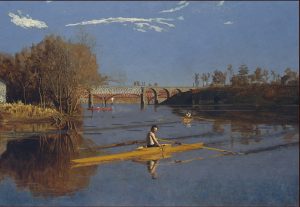
“The Champion Single Sculls”,
Bill Miller Collection
Amherst, Bowdoin, Brown and Harvard formed the Rowing Association of American Colleges. Massachusetts Agricultural College defeated Harvard and Brown on July 21 in a three mile race for six-oared crews on the Connecticut River near Springfield, Mass. (the victorious shell is now at Mystic Seaport).
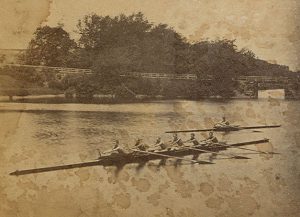
from College Regatta Worcester stereoview, E Berg photographer,
Bill Miller Collection
The Ward brothers defeated two English and three American fours in an international four mile turn race at Saratoga (September 11).
The October regatta of Harlem’s Empire City Rowing Club included a double sculls race for women, an image of which was published in Frank Leslie’s Illustrated News.
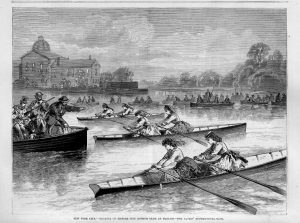
Frank Leslie’s Illustrated News, Oct. 14, 1871,
Thomas E Weil Collection
1872 · Questions about the amateur status of several of the oarsmen in a Philadelphia regatta sponsored by the Schuylkill Navy (June 13-14) prompted debate throughout the U.S. rowing community, and lead to the establishment of The National Association of Amateur Oarsmen (which became the United States Rowing Association a century later), the first national amateur team sport organization in the United States (August 28).
Three modern eights purchased from the London Rowing Club by three Philadelphia boat clubs reintroduced eights racing to the U.S. in a Philadelphia Thanksgiving regatta (November 28); among those oarsmen was the future noted illustrator A.B. Frost. One of those eights is depicted in the background of Eakin’s two 1873 watercolors of John Biglin.
1873 · Bob Cook, the Yale captain, learned the English style of stroking at Oxford, and introduced it to U.S. college rowing, where it became the dominant stroke in college programs through the end of the century.
Both Oxford and Cambridge used sliding seats in the Boat Race for the first time.
Rowing clubs were formed in Argentina, Peru and Poland [Dodd].
1875 · Wellesley College established the oldest surviving organized women’s rowing program, while Charles Courtney began training women to row at the Union Springs seminary.
U.S. professional Michael Davis patented the swivel oarlock.
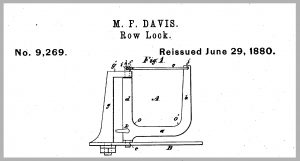
US patent #165,072 reissued 1880
1876 · Rowing was one of three sports (the others were yachting and riflery) included in the U.S. Centennial celebration in Philadelphia. Edward “Ned” Hanlan, an unheralded oarsman from Canada, won the singles championship, and the Beaverwyck four from Albany, New York defeated the London Rowing Club in the amateur championship fours event.
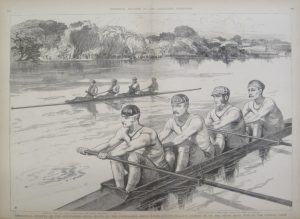
Frank Leslie’s Illustrated News, Sep 16, 1876,
Bill Miller Collection
Harvard and Yale adopted the eight-oar over the six-oar, and began racing at the four-mile distance. Yale withdrew from the intercollegiate regatta. Harvard withdrew in 1877, and, for the next decade, while Harvard and Yale waged their annual contest in eights (moving from Springfield to the Thames at New London in 1878, in which year the first observation train was run), most other rowing colleges contested in fours.
Two women raced single sculls over a mile on the Mohongahela River at Pittsburgh.
Michael Davis patented a sliding rigger.
1878 · Columbia was the first U.S. crew to win at Henley, taking the Visitors Challenge Cup for coxless-fours.
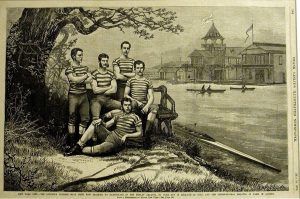
Frank Leslie’s Illustrated News, May 18, 1878,
Bill Miller Collection
The North German Regatta Association adopted the 2,000 meter distance for racing [Dodd].
1879 · The first Childs Cup, the oldest college trophy, for a regatta among Columbia, Princeton and Pennsylvania, was won by a Pennsylvania four; the regatta switched to eights in 1889.
Frenchy Johnson was the first prominent person of color in professional sculling.
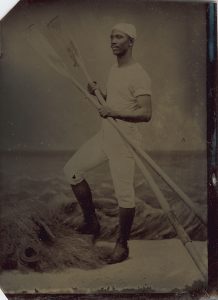
A restrictive definition of “amateur” was adopted by the Henley Stewards and the newly formed Metropolitan Rowing Association.
1880 · Ned Hanlan, the “Boy in Blue,” generated unprecedented international news coverage as a sports figure in beating the Australian Edward Trickett for the first professional rowing “World Championship” to be contested in England, remaining undefeated until his loss to William Beach on the Paramatta in Australia in 1884.
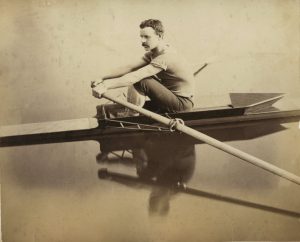
Michael Davis patented the “Leg-O-Mutton” blade, a predecessor design to today’s hatchet shape, as well as a steering footstretcher [Miller].
1882 · The Amateur Rowing Association was formed by the Oxbridge wing of English rowing.
1883 · Rowing colleges other than Yale and Harvard joined to establish an Intercollegiate Association rowing in fours.
1885 · Charles Courtney took full-time charge of the rowing program at Cornell, becoming the first professional oarsman to successfully transition to permanent employment as a college coach.
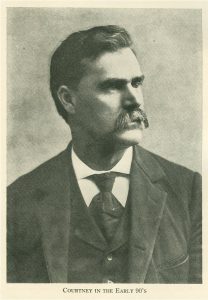
1887 · Allen & Ginter, a Virginia tobacco company, issued the first set of sport cards as premiums in packs of cigarettes; the first 50 champions included ten professional oarsmen and ten professional baseball players – no other sport had as many.
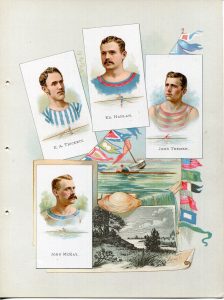
Bill Miller Collection
1889 · The other U.S. rowing colleges followed Harvard and Yale to rowing in eights and racing in New London.
1890 · Reform minded English oarsmen established the National Amateur Rowing Association (NARA) as a more inclusive body than the ARA. The NARA merged with the ARA in 1955, bringing to a close a bitter debate over amateur status that had plagued British rowing for almost a century.
1892 · ZLAC, the first women’s rowing club (named after four of the founding members, Zulette, Lena, Agnes and Caroline), was established in San Diego, California.
The Federation Internationale des Societes d’Aviron (FISA) was formed as the first international amateur team sport governing body.
1893 · FISA held its first European rowing championships, in Orta, Italy.
The first UK women’s collegiate “boating society” was organized in England, at Cambridge’s Newnham College.
The first major West Coast collegiate crew program was established at Cal-Berkeley.
The Boston Athletic Association sponsored rowing programs for seven Boston schools, expanding to 13 schools the following year.
1895 · The newly formed Intercollegiate Rowing Association (IRA) formed by Columbia, Cornell and Pennsylvania, began holding its four mile championship races for eights on the Hudson River at Poughkeepsie, New York. In 1952, after two years on the Ohio River at Marietta, the event moved to Lake Onondaga, at Syracuse, New York. Then it moved to the Cooper River, Camden NJ. It now rotates between East Coast (Lake Mercer, NJ) and West Coast (Sacramento, CA) sites.
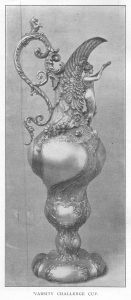
1896 · Professional rowing events were eliminated from the Boston City regattas, signaling the end of professional competition in the U.S.
Rowing events were scheduled to be held at the Greek port of Pireaus in conjunction with the first modern Olympics in Athens in 1896, but were canceled due to bad weather at the site; rowing has been in every Games since then, and is the only Olympic team sport with that record of longevity and continuity.
Pierre de Coubertin quotation – 1911 “When, 25 years ago, I was seeking something on which to base the revival of sport in schools, it seemed to me that rugby and rowing were best suited to play the most important roles. A team of rugby players or a crew of highly trained and well drilled oarsmen embody those qualities of energy, endurance, patience, unselfish effort, self-effacement and disinterest concerning the final outcome which make for all that is most admirable and profitable in sport.”
Two fishermen from New Jersey, Harbo and Samuelson, rowed from New York to Ireland in an open boat.
F.J. Furnivall founded the Hammersmith Sculling Club for Girls and Men due to his belief that “the exclusion of women from aquatic sport was pernicious”; he encouraged working women to row, and espoused sculling over sweeps.
1897 · Edward H. Ten Eyck became the first American to win the Diamonds at Henley.
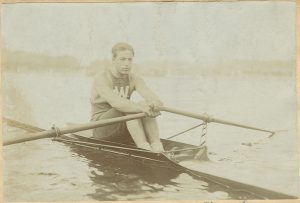
The Sedgeley Club was established in Philadelphia for rowing women.
